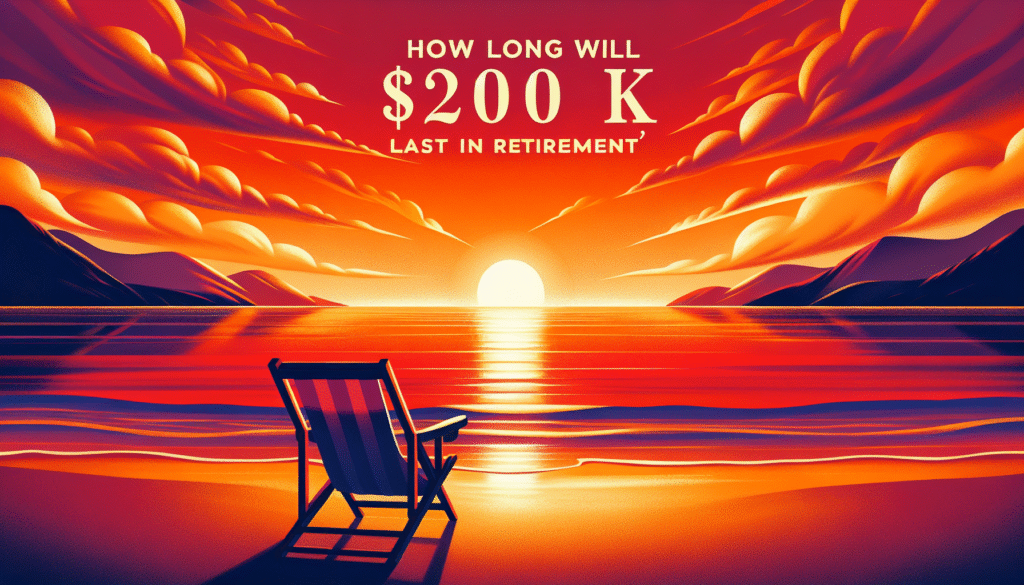Have you ever wondered how long $200,000 could last you in retirement? Whether you’re just starting to think about your post-work years or you’ve been planning for a while, considering how far your savings will stretch is a crucial part of your retirement plan. Let’s walk through various factors that could impact the longevity of your $200,000 nest egg.

This image is property of pixabay.com.
Understanding Your Retirement Needs
The first step in gauging how long $200,000 will last is understanding your needs during retirement. Everyone’s lifestyle and health vary, meaning what works for one person may not work for another.
Estimating Monthly Expenses
A fundamental aspect here is estimating your monthly expenses. Consider all categories such as housing, food, healthcare, transportation, leisure, and possible travel. Are you planning to stay in your current home, relocate to a smaller place, or maybe travel extensively? These choices drastically affect your monthly expenditures and therefore, the pace at which your retirement savings diminish.
Healthcare Costs
Healthcare is another critical element to consider. Even if you’re healthy now, medical expenses often increase as you age. For someone on Medicare, there might still be significant out-of-pocket expenses. Do you have a separate health care fund, or will this come out of your main retirement savings? Insurance, routine check-ups, and unforeseen medical procedures can quickly add up.
Expected Income from Other Sources
Another essential factor in assessing how long $200,000 will last is identifying if you have other income sources. These could include Social Security, pensions, annuities, or investment dividends. Let’s consider how these might play into your retirement savings.
Social Security
Social Security often plays a critical role in retirement financing. The benefits you receive depend on your lifetime earnings, the age you start claiming benefits, and your marital status. Knowing how much income you can expect here each month will help determine how much of those $200k you’ll need to draw down.
Pensions and Annuities
If you are fortunate enough to receive a pension or have invested in annuities, these can provide a reliable income stream. Different types of pensions and annuities offer various payment schedules and amounts, affecting how much additional financial support they provide on top of your savings.
Investment Income
Income from investments, such as dividends or property rentals, can also supplement your retirement savings. A well-diversified investment portfolio may continue to grow or provide steady income, reducing the need to dip into your retirement savings as aggressively.
Withdrawal Rate Strategy
Once you’ve calculated your expected monthly expenses and identified other income sources, your withdrawal strategy is the next consideration. Withdrawing from your nest egg involves balancing sufficient income generation with the risk of depleting your funds too quickly.
The 4% Rule
The 4% rule is a popular guideline for safe withdrawal. It suggests that you can withdraw 4% of your savings annually, adjusting for inflation, without exhausting your funds for at least 30 years. But with $200,000, this equates to about $8,000 annually, or roughly $667 monthly. Would this cover a significant portion of your expenses? If not, you may need to consider additional sources of income or a more aggressive investment strategy.
Life Expectancy and Withdrawal Adjustments
Your life expectancy also plays a significant role in determining your withdrawal strategy. Longer life expectancy means you need to stretch the $200k further. On the flip side, if you expect to need your savings for fewer years, you might afford larger withdrawals. Re-assessing your strategy as circumstances change will ensure you adapt to new needs and conditions.
Inflation Impact
Inflation is another critical aspect to consider in determining how long $200k will last. Even a modest inflation rate can significantly erode purchasing power over time.
Historical Inflation Rates
Historically, an average inflation rate of about 3% has been typical in the United States. This rate means that over 20 years, the cost of living could double. Your withdrawal strategy should account for increasing expenses due to inflation to maintain your standard of living.
Inflation-Protected Investments
To shield yourself against inflation, consider holding some of your retirement savings in inflation-protected securities, such as Treasury Inflation-Protected Securities (TIPS) or real assets like real estate. These investments can provide a hedge against rising prices, helping your savings maintain their value over time.

Lifestyle Adjustments
Sometimes, sustaining your savings for longer might require lifestyle adjustments. Even minor changes can significantly impact the longevity of your funds.
Downsizing
One option might be to downsize your living accommodations. By moving to a smaller home or an area with a lower cost of living, you could drastically reduce expenses related to housing, utilities, and even taxes.
Frugality and Budgeting
Adopting a frugal lifestyle and strict budgeting can also help extend your savings. Identifying areas where you can cut back doesn’t mean sacrificing quality of life; instead, it could entail more mindful spending and selecting cost-effective alternatives.
Post-Retirement Income
Consider earning a part-time income or monetizing a hobby. Not only can this provide supplementary income, but it also offers an opportunity to stay engaged and active. Whether freelancing or turning a passion into profit, any income can significantly ease the burden on your retirement savings.
Tax Considerations
Taxes can further impact how long $200,000 lasts. Your withdrawal strategy might benefit from tax-efficient approaches, lowering the share of your withdrawals going towards taxes.
Tax-Advantaged Accounts
Utilizing tax-advantaged accounts, like Roth IRAs, where withdrawals in retirement can be tax-free, could mitigate tax impacts. Balancing withdrawals from taxable, tax-deferred, and tax-free accounts can extend the life of your savings by minimizing tax liability.
Tax Bracket Optimization
Maintaining awareness of tax brackets is essential. Large withdrawals can push you into a higher tax bracket, increasing your tax bill. Strategic withdrawal planning can keep your taxable income at a lower limit, preserving more of your savings for personal use.

This image is property of pixabay.com.
Financial Tools and Resources
There are numerous tools and resources available that can help in planning and estimating how long your retirement savings will last.
Retirement Calculators
Use online retirement calculators that factor in your complete financial picture – expenses, income, taxes, and inflation. These tools can offer personalized projections to help you visualize your financial trajectory.
Professional Financial Advisors
Consulting with a financial advisor may provide personalized insights or strategies for balancing your savings, potential additional income, and investments. Professionals can help assess scenarios and devise strategies to maximize the longevity of your savings.
Real-Life Scenarios
To put theory into practice, consider some hypothetical scenarios.
| Scenario | Monthly Expenses | Expected Income (Social Security, etc.) | Income from $200k | Retirement Longevity |
|---|---|---|---|---|
| Minimalist Living | $1,500 | $1,200 | $300 | Longer with adjustments |
| Modest Lifestyle | $2,000 | $1,000 | $1,000 | Balanced, subject to inflation |
| Travel-Focused Retirement | $3,000 | $1,000 | $2,000 | Shortened unless additional income is found |
Each illustrates different lifestyle choices, expenses, and income combinations, showing how they might influence how long $200,000 would last.

This image is property of pixabay.com.
Conclusion
Deciphering how long $200,000 will last in retirement involves understanding your expenses, potential income, and strategic financial planning. Consider inflation, taxes, withdrawal rates, and lifestyle adjustments as critical factors in this equation. The key is a comprehensive plan that includes contingency scenarios so you can enjoy retirement without constantly worrying about outliving your savings. Remember, every small decision today contributes to a future where your financial well-being is within your control.
